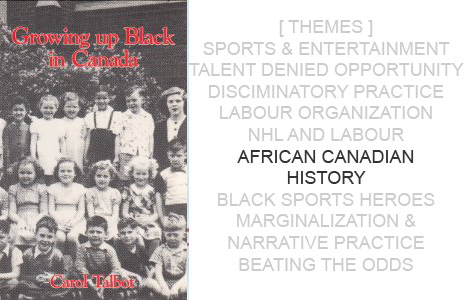"Our Hair"
Overview
In this lesson students will discuss the social, cultural and political significance of a variety of African Canadian hairstyles. Students will use a number of skills including observation, interpretation, analysis and critical thinking to discuss various aspects of African Canadian Hair and hairstyles. Discussion may move to a broader consideration of style and identity.
Purpose:
- to introduce the various styles of African Canadian hair
- to discuss the generational differences in the perception of African Canadian Hair
- to identify the social and political importance of hair styles as class distinction and as political statements
- to understand the American media’s role in African Canadian’s self perception of hair
Related online material:
Dr. Althea Prince, The Politics of Black Women’s hair. Insomniac Press: Toronto, 2010, Introduction
http://www.insomniacpress.com/resources/978-1-897178-87-4_sampler.pdf
Video resources for Teachers on Madame C.J. Walker
http://www.madamcjwalker.com/students-teachers/audiovideo-sources/
Lesson Plan Description:
The class will read excerpts from Pourin Down Rain,and Growing up Black In Canada that discuss the problems and pleasures of African Canadian hair. Working both individually and in small groups, the student will analyze the social and political impacts of dreadlocks, Afros, bald heads, natural hair, weaves and braids by deconstructing popular media representations and speaking with relatives.
Prior Knowledge Required:
Students should be familiar with a diversity of hair styles and types as related to the African diaspora. Students should also be familiar with a variety of opinions on African Canadian hair.
Required Time: 4 sessions
Session 1: Read and discuss Carol Talbot’s chapter entitled “Only Her Hairdresser Knows for Sure”. Students should share their experiences of learning how to style their hair. Each student will write a reflection paper on what they like about their hair and what are their favourite hairstyles.
Session 2: Read excerpts from Pourin Down Rain that discuss the author’s experiences with her hair and favourite hairstyles. Compare and contrast Foggo’s and Talbot’s accounts. Research the importance of Madame C.J. Walker to the lives of African Canadian women in regards to hairstyling
Session 3: Utilize images from magazines and other popular media to discover different styles of black hair, including dreadlocks, afros, twists, weaves, braids, relaxed and cameos. Identify which countries these styles originated and/or are most popular. Interview a family member with one of the hairstyles researched in class.
Session 4: Oral presentation of relative’s interview about black hair and hairstyles.
Planning Notes:
- review all media clips for language use and appropriate content for the age group
- book and set up available audio visual equipment
- bookmark or download all necessary resources from the web
- ensure all students have access to a family member willing to discuss black hair
Materials for teacher
- Pourin Down Rain and Growing up Black In Canada
- Politics of Black Women’s Hair by Dr. Althea Prince (introduction provided)
- selected video on Madame C.J. Walker
- Oral presentation rubric
- magazines such as Ebony, Essence, Jet, and O
Accomodations/Modifications
Interviews of relatives can be extended to any elder in the community for those with few or no relatives with black hair; For older classes, the film “Good Hair” is an additional resource from the African American context, while the book by Dr. Althea Prince can work well in a Canadian context.
Assessment/Evaluation Description
- Teacher observation
- Discussion participation
- Successful completion of the interivew
- Oral presentation according to oral presentation rubric
Resources
Foggo, Cheryl. (1990) Pourin’ Down Rain Calgary: Detselig Enterprises Ltd.
Talbot, Carol. (1984) Growing Up Black In Canada. Stratford: Williams-Wallace Publishers
Prince, Althea. (2009). The Politics of Black Women’s Hair. Toronto: Insomniac Press
Video sources:
http://www.madamcjwalker.com/students-teachers/audiovideo-sources/
TEACHING AND LEARNING STRATEGIES
Discussion: Discuss how the author’s experience might mirror those of the students. Ask “How do the author’s opinions and experiences with their hair relate to your own experiences?”
Writing: Students will write a personal reflection of their experiences with their hair.
Oral Presentation: Students will share with the class the experiences of their relatives (or a community member) drawn from interviews conducted about the person’s hair.


